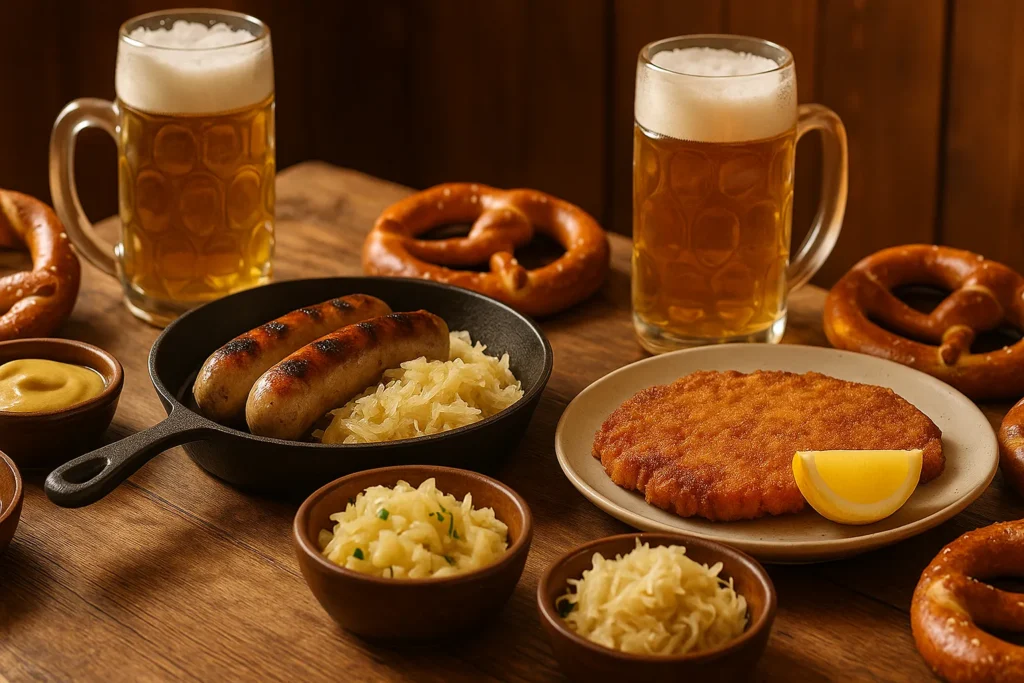
Ever wondered what makes German food so satisfyingly hearty and comforting? It’s not just the sausages or pretzels — though those are reason enough to love it! German cuisine is about warmth, tradition, and that unbeatable combination of simplicity and soul. From crispy schnitzels to tangy sauerkraut, every dish tells a story — one that’s been passed down through generations. So grab your fork (and maybe a stein of beer), because we’re diving into the bold, comforting, and oh-so-delicious world of authentic German flavors!
1. The Soul of German Cuisine: Comfort Meets Craft
German food isn’t about dainty portions or overly fancy plating — it’s about comfort and craftsmanship. Think dishes that hug your soul after the first bite. Every region of Germany has its specialties, and every meal feels like a celebration of local ingredients and time-honored techniques.
The secret? Hearty simplicity. German cooks know that you don’t need twenty spices or ten sauces to make something taste amazing. Just a few quality ingredients — potatoes, cabbage, meat, and bread — combined with care, and you’ve got magic on a plate.
2. Start with the Classics: Flavors That Define Germany
You can’t talk about authentic German food without mentioning the classics. These are the dishes that every local knows and every visitor falls in love with:
- Bratwurst – The iconic German sausage, grilled to perfection and served with mustard or sauerkraut. There are hundreds of varieties, each with its own regional twist.
- Schnitzel – A thin breaded cutlet (often pork or veal) fried until crispy and golden. It’s simple, satisfying, and makes you wonder why you ever settled for chicken nuggets.
- Sauerkraut – Tangy, fermented cabbage that’s both healthy and delicious. It adds a zesty kick to hearty meat dishes and balances the richness beautifully.
- Kartoffelsalat (Potato Salad) – Every German household has its version. Some add bacon, some vinegar, some mayonnaise — all are equally tasty and perfect for any occasion.
- Pretzels (Brezn) – Golden brown, twisted perfection. Soft inside, slightly chewy outside, and best enjoyed with butter or a cold beer.
Together, these dishes are the beating heart of German cuisine — humble, flavorful, and deeply satisfying.
3. Regional Treasures: Beyond Sausages and Beer
Germany’s culinary landscape is as diverse as its countryside. From the rolling vineyards of the Rhine Valley to the snowy Bavarian Alps, every region adds its own flair:
- Bavaria: Home of pretzels, weisswurst (white sausage), and the legendary Oktoberfest beer culture. Expect hearty portions and a love for anything that pairs well with beer.
- Berlin: Street food heaven. You’ll find Currywurst, the city’s beloved invention — sausage smothered in ketchup and curry powder. It sounds odd, but one bite and you’ll be hooked.
- Swabia: Famous for Maultaschen, delicious stuffed pasta pockets (think German ravioli) filled with meat, spinach, and onions.
- The Rhineland: Known for its Sauerbraten, a sweet-and-sour pot roast that’s marinated in vinegar and spices before being slow-cooked to tender perfection.
No matter where you go in Germany, one thing’s certain — you’ll never leave hungry.
4. The Power of Bread: German Baking Perfection
Bread in Germany isn’t just food — it’s culture. With over 300 varieties, it’s safe to say that Germans take their bread seriously. Whether it’s the dark, dense pumpernickel, the hearty rye loaves, or the crusty Brötchen rolls, every type has its own purpose and personality.
In fact, bread is such a staple that many Germans eat it multiple times a day — at breakfast with butter and jam, and again at dinner with cold cuts and cheese. So if you ever visit Germany, skip the croissant and try a slice of authentic rye bread. You’ll never look at toast the same way again.
5. German Desserts: Sweet Traditions Worth Every Bite
When it comes to desserts, German cuisine delivers with the same mix of heartiness and comfort.
- Apfelstrudel – A flaky pastry filled with spiced apples and raisins, often served warm with a scoop of vanilla ice cream. Heaven in every bite.
- Black Forest Cake (Schwarzwälder Kirschtorte) – Layers of chocolate sponge cake, whipped cream, and cherries, topped with chocolate shavings. It’s as decadent as it sounds.
- Lebkuchen – German gingerbread cookies that fill the air with the smell of Christmas. Soft, spiced, and full of nostalgia.
These desserts prove that German cooking isn’t all about sausages and potatoes — it’s also about indulgence done right.
6. Drinks with Character: More Than Just Beer
Yes, Germany is world-famous for its beer, and for good reason. Each region crafts its own style — from crisp pilsners to malty bocks to unfiltered wheat beers. But that’s just one part of the story.
Germany also produces excellent wines, particularly white varieties like Riesling from the Rhine and Moselle regions. Light, fruity, and aromatic — they pair perfectly with traditional German dishes. And if you’re feeling adventurous, try Apfelwein (apple wine) from Frankfurt — tangy, refreshing, and utterly unique.
So, while beer gets the spotlight, the German beverage scene is full of delightful surprises.
7. The Spirit of German Dining: Community and Celebration
In Germany, food isn’t just nourishment — it’s a reason to gather. Whether it’s a family Sunday roast, a festive Christmas market, or an Oktoberfest celebration, meals are about togetherness.
The Germans have a word for this cozy, communal feeling: Gemütlichkeit. It’s that sense of warmth, comfort, and belonging you get when sharing good food with good company. And honestly, that’s the best seasoning any meal can have.
8. Cooking German at Home: Easy Ways to Start
Bringing German flavor into your kitchen is easier than you might think. You don’t need to own a beer hall or wear lederhosen (though, no judgment if you do). Just start with a few staples:
- Butter, onions, and garlic – The holy trinity of German cooking.
- Potatoes – Mashed, boiled, fried, or baked — they’re the backbone of countless dishes.
- Mustard and vinegar – For that tangy edge German cuisine is famous for.
- Cabbage – From sauerkraut to red cabbage, it’s a must-have side dish.
Start small with dishes like schnitzel, potato salad, or Bratwurst with sauerkraut, and soon you’ll be channeling your inner German chef.
9. A Dash of Humor: Don’t Take It Too Seriously
German food might look hearty and serious, but cooking it should be fun! Burn your first schnitzel? No problem — just call it “extra crispy.” Drop your pretzel dough on the floor? The dog will thank you.
Cooking is about joy, experimentation, and laughter. And if you end your evening full, happy, and maybe a little sleepy, then congratulations — you’ve just had an authentically German meal.
